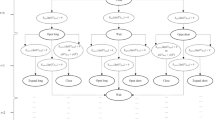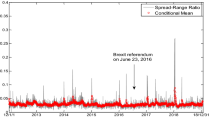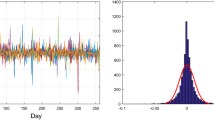Abstract
We propose a heterogeneous agent model including the fundamentalists, chartists, and carry traders, to describe the dynamics of exchange rates, and examine the effects of Tobin Tax on the equilibrium exchange rates. A theoretical analysis shows that an increase of Tobin tax always reduces the trading volume, and its impact on the equilibrium exchange rate depends on the agents’ expectations of exchange rate movements and their weights in the markets. Our simulation exercise shows that an increase in Tobin tax may lead to an increase in volatility and price distortion and a decrease in the kurtosis and the trading volume. Our results suggest that the Tobin tax could be an emergency measure, but not a long-term policy tool to suppress speculation.










Similar content being viewed by others
Notes
References
Aliber, R. Z., Chowdhry, B., & Yan, S. (2003). Some evidence that a Tobin tax on foreign exchange transactions may increase volatility. Review of Finance, 7(3), 481–510.
Berentsen, A., Huber, S., & Marchesiani, A. (2016). The societal benefit of a financial transaction tax. European Economic Review, 89, 303–323.
Buss, A., Dumas, B., Uppal, R., & Vilkov, G. (2016). The intended and unintended consequences of financial-market regulations: A general-equilibrium analysis. Journal of Monetary Economic, 81, 25–43.
Dávila, E. (2020). Optimal Financial Transaction Taxes. NBER Working Papers 27826, National Bureau of Economic Research, Inc.
De Grauwe, P., & Grimaldi, M. (2006). Exchange rate puzzles: A tale of switching attractor. European Economic Review, 50(1), 1–33.
Demary, M. (2006). Transaction taxes, trader’s behavior and exchange rate risks. Christian-Albrechts University of Kiel, Department of Economics, Working Paper.
Demary, M. (2010). Transaction taxes and traders with heterogeneous investment horizons in an agent-based financial market model. Economics: the Open-Access, Open-Assessment E-Journal, 4(8), 1–44.
Ehrenstein, G., Westerhoff, F., & Stauffer, D. (2005). Tobin tax and market depth. Quantitative Finance, 5, 213–218.
Flaschel, P., Hartmann, F., Malikane, C., & Proaño, C. R. (2015). A behavioral macroeconomic model of exchange rate fluctuations with complex market expectations formation. Computational Economics, 45(4), 669–691.
Franke, R. (2012). Microfounded animal spirits in the new macroeconomic consensus. Studies in Nonlinear Dynamics and Econometrics. https://doi.org/10.1515/1558-3708.1898
Jongen, R., Verschoor, W. F. C., Wolff, C. C. P., & Zwinkels, R. C. J. (2012). Explaining dispersion in foreign exchange expectations: A heterogeneous agent approach. Journal of Economic Dynamics & Control, 36, 719–735.
Lavicka, H., Lichard, T., & Novotný, J. (2016). Sand in the wheels or the wheels in sand? Tobin taxes and market crashes. International Review of Financial Analysis, 47, 328–342.
Li, X. P., Tong, B., & Zhou, C. Y. (2020). Uncertainty aversion, carry trades and agent heterogeneity in the FX market. Finance Research Letters, 36, 101354.
Li, X. P., Zhou, C. Y., & Tong, B. (2019). Carry trades, agent heterogeneity and the exchange rate. International Review of Economics and Finance, 64, 343–358.
Mannaro, K., Marchesi, M., & Setzu, A. (2008). Using an artificial financial market for assessing the impact of Tobin-like transaction taxes. Journal of Economic Behavior & Organization, 67(2), 445–462.
Pellizzari, P., & Westerhoff, F. (2009). Some effects of transaction taxes under different microstructures. Journal of Economic Behavior and Organization, 72(3), 850–863.
Pojarliev, M., & Levich, R. (2008). Do professional currency managers beat the benchmark? Financial Analyst Journal, 64(5), 18–30.
Pojarliev, M., & Levich, R. (2010). Trades of the living dead: Style differences, style persistence and performance of currency fund managers. Journal of International Money and Finance, 29(8), 1752–1775.
Spronk, R., Verschoor, W. F. C., & Zwinkels, R. C. J. (2013). Carry trade and foreign exchange rate puzzles. European Economic Review, 60, 17–31.
Stanek, F., & Kukacka, J. (2018). The impact of the Tobin tax in a heterogeneous agent model of the foreign exchange market. Computational Economics, 51(4), 865–892.
Tobin, J. (1978). Aproposal for international monetary reform. Eastern Economic Journal, 4, 153–159.
Westerhoff, F. (2003). Heterogeneous traders and the Tobin tax. Journal of Evolutionary Economics, 13(1), 53–70.
Westerhoff, F. (2004). Market depth and price dynamics: A note. International Journal of Modern Physics C, 15(7), 1005–1012.
Westerhoff, F., & Dieci, R. (2006). The effectiveness of Keynes-Tobin transaction taxes when heterogeneous agents can trade in different markets: A behavioral finance approach. Journal of Economic Dynamics and Control, 30(2), 293–322.
Yin, Z. C., Peng, H. F., Xiao, W. G., & Xiao, Z. M. (2022). Capital control and monetary policy coordination: Tobin tax revisited. Research in International Business and Finance, 59, 101514.
Funding
This work is supported by National Social Science Foundation of China (No. 19BJL122).
Author information
Authors and Affiliations
Corresponding author
Ethics declarations
Conflict of interest
The authors declared that they have no conflicts of interest.
Additional information
Publisher's Note
Springer Nature remains neutral with regard to jurisdictional claims in published maps and institutional affiliations.
Appendices
Appendix 1: Derivation of the Optimal Foreign Currency Holding
The purpose of the foreign exchange market trader is to optimize the portfolio of assets on domestic and foreign assets to maximize the expected utility. Suppose the trader’s expected utility function is:
We substitute \(W_{i,\;t + 1}\) into the above formula and get
If \(\Delta f_{t}^{i} < 0\), the trader is a seller. From the first order condition \(\frac{\partial L}{{\partial f_{t}^{i} }} = 0\), we can get
Since \(f_{t}^{i} < f_{t - 1}^{i}\), we have
Similarly, if \(\Delta f_{t}^{i} > 0\), the trader is a buyer. The first order condition implies that
Since \(f_{t}^{i} > f_{t - 1}^{i}\), we have
Finally if \(\Delta \,f_{t}^{i} = 0\), the investor decides not to trade. Because \(L\) is constant, \(\frac{\partial L}{{\partial f_{t}^{i} }} = 0\) always holds when \(s_{1} \le s_{t} \le s_{2}\).
Proof of Proposition 1
The market-clearing condition showed as Eq. (12) implies that
Substitute Eq. (6) into the above equation, then we can have
along with \(\frac{{\partial f_{t}^{i} }}{\partial \tau } = - \frac{{s_{t} {\text{sgn}} \left( {\Delta \,f_{t}^{i} } \right)}}{{G_{i} }}\) and \(\frac{{\partial f_{t}^{i} }}{\partial s} = - \frac{{1 + r_{d,t} + \tau {\text{sgn}} \left( {\Delta f_{t}^{i} } \right)}}{{G_{i} }}\), where \(G_{i} = \lambda v_{t}^{i} \left( {1 + r_{f,t} } \right)^{2}\).
Thus we prove Proposition 1.
Proof of Proposition 2
The equilibrium response of \(f_{t}^{i}\) to a change in the tax \(\tau\) is given by
By substituting \(\frac{{\partial f^{i} }}{\partial \tau } \), \(\frac{{\partial f^{i} }}{\partial s}\) and \(\frac{ds}{{d\tau }}\) into Eq. (23), we have
Let \(e_{i} \) represent the expression in the curly braces, and it can be rewritten as:
where \(L^{*} = \frac{{\sum_{i \in S} w_{t}^{i} /G_{i} }}{{\sum_{i \in B} w_{t}^{i} /G_{i} }} \in \left( {0,\;\infty } \right)\) is the ratio of sellers’ risk aversion to buyers’ risk aversion. It is straightforward to show that \(e_{i} > 0\) for both buyers and sellers.
Therefore, the sign of \(\frac{{df_{t}^{i} }}{d\tau } \) is determined by that of \(\frac{{\partial f_{t}^{i} }}{\partial \tau }\). According to Eq. (6), we can gain that \(\frac{{\partial f_{t}^{i} }}{\partial \tau } = \frac{{ - s_{t} {\text{sgn}} \left( {\Delta f_{t}^{i} } \right)}}{{G^{i} }}\). When \(\Delta f_{t}^{i} > 0\), which implies that the trader is a buyer and \(i \in B\), we can get \(\frac{{df_{t}^{i} }}{d\tau } < 0\). Otherwise, when \(\Delta f_{t}^{i} < 0\) which implies that the trader is a seller and \(i \in S\), we can get \(\frac{{df_{t}^{i} }}{d\tau } > 0\). Thus we can prove Proposition 2a).
Let \(vol_{t}^{i} = \left| {f_{t}^{i} - f_{t - 1}^{i} } \right|\), we have \(\frac{{dvol_{t} }}{d\tau } = \sum w_{t}^{i} \frac{{dvol_{t}^{i} }}{d\tau } = \mathop \sum \limits_{i \in B} w_{t}^{i} \frac{{df_{t}^{i} }}{d\tau } - \mathop \sum \limits_{i \in S} w_{t}^{i} \frac{{df_{t}^{i} }}{d\tau }\). So Proposition 2b) is proved as \({ }\mathop \sum \limits_{i \in B} w_{t}^{i} \frac{{df_{t}^{i} }}{d\tau } < 0\) and \(\mathop \sum \limits_{i \in S} w_{t}^{i} \frac{{df_{t}^{i} }}{d\tau } > 0\).
Rights and permissions
Springer Nature or its licensor (e.g. a society or other partner) holds exclusive rights to this article under a publishing agreement with the author(s) or other rightsholder(s); author self-archiving of the accepted manuscript version of this article is solely governed by the terms of such publishing agreement and applicable law.
About this article
Cite this article
Li, X., Zhou, C. Tobin Tax, Carry Trade, and the Exchange Rate Dynamics. Comput Econ 63, 1627–1647 (2024). https://doi.org/10.1007/s10614-023-10377-4
Accepted:
Published:
Issue Date:
DOI: https://doi.org/10.1007/s10614-023-10377-4




